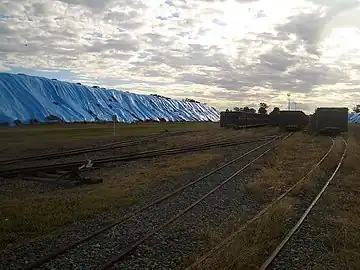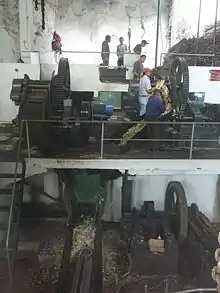Bagasse
Bagasse (/bəˈɡæs/ bə-GAS) is the dry pulpy fibrous material that remains after crushing sugarcane or sorghum stalks to extract their juice.[1] It is used as a biofuel for the production of heat, energy, and electricity, and in the manufacture of pulp and building materials. Agave bagasse is similar, but is the material remnants after extracting blue agave sap.

Etymology
The word comes from bagasse (French) and bagazo (Spanish), meaning refuse or trash. It originally referred to the material left after pressing olives, palm nuts, and grapes. The word eventually came to be used in the context of processing of plants such as sugarcane and sugar beets. Today, it usually refers to by-products of the sugarcane mill.[1]
Description
Bagasse is the solid by-product when the liquid components are extracted from plants. Much of the core of those plants is a heterogeneous "pith" fibre. This fibre is primarily parenchyma tissue, along with bast, rind, or stem fibers of the sclerenchyma.
Here's an example chemical analysis of washed and dried bagasse:[2]
- Cellulose: 45–55%
- Hemicellulose: 20–25%
- Lignin: 18–24%
- Ash: 1–4%
- Waxes: <1%
Production
For every 10 tonnes of sugarcane crushed, a sugar factory produces nearly three tonnes of wet bagasse. It is challenging to use this byproduct directly as a fuel because of the high moisture content, typically 40–50 percent. Instead, bagasse is typically stored prior to further processing.
For electricity production, the bagasse is stored under moist conditions. Under these conditions, the bagasse undergoes a mild exothermic process as the residual sugars slightly degrade.
For paper and pulp production, the bagasse is normally stored wet so as to facilitate the subsequent removal of any remaining sugar as well as the short pith fibres. These fibres would impede the paper making process.
Uses

Numerous research efforts have explored using bagasse in the production of bio-based materials and as a biofuel in renewable power generation.[3]
Fuel
Sugar mills often use bagasse as a primary fuel source. When burned in quantity, bagasse produces enough heat energy to fully power a typical sugar mill, with some energy to spare. Cogeneration is a common setup, with this extra energy sold to the consumer electrical grid. Historically, bagasse was also used to fuel steam locomotives that brought the cut cane to the mills.
The CO2 emissions from burning the bagasse in a sugarcane plant is less than the amount of CO2 absorbed from the atmosphere when the sugarcane grows, which could make the process carbon-neutral or better.[4] In contrast, a study in the International Journal of Global Warming warned that electricity generation with bagasse would never be fully carbon-free but did represent a large reduction in carbon emissions compared to the use of diesel.[5] In countries such as Australia, sugar factories contribute this "green" power to the electricity grid. Hawaiian Electric Industries also burns bagasse for cogeneration.
Ethanol produced from the sugar is a popular fuel in Brazil. The cellulose-rich bagasse is also being investigated for its potential in producing commercial quantities of cellulosic ethanol. For example, until May 2015, BP operated a cellulosic ethanol demonstration plant in Jennings, Louisiana.
Bagasse's potential for use in advanced biofuels has been demonstrated by several researchers.[6][7] However, the suitability of these crude fuels for conventional engines and their compatibility with conventional fuels and has not yet been proven.[8]
Pulp, paper, board and feed
In many tropical and subtropical countries such as India, China, Colombia, Iran, Thailand, and Argentina, bagasse is commonly used instead of wood in the production of pulp, paper and board. This substitution produces pulp with physical properties that are well suited for printing and notebook paper, tissue products, boxes, and newspapers.[2] It can also be used for making boards resembling plywood or particle board, known called bagasse boards and Xanita boards. These are widely used in the production of partitions and furniture.
The industrial process to convert bagasse into paper was developed in 1937 at a small laboratory in Hacienda Paramonga, a sugar mill on the coast of Peru owned by the W.R. Grace Company. Using a promising method invented by Clarence Birdseye,[9][10] the company bought an old paper mill in Whippany, New Jersey and shipped bagasse from Peru there to test the viability of the process on an industrial scale. The first bagasse paper manufacturing machines were designed in Germany and installed in the Cartavio sugar cane plant in 1938.[11]
On January 26-27, 1950, the Noble & Wood Machine Company, the Kinsley Chemical Company, and the Chemical Paper Company jointly demonstrated the first successful commercial production of newsprint produced from bagasse at Chemical Paper's mills in Holyoke. The process's first use was in the printing of a special edition of the Holyoke Transcript-Telegram. This demonstration was done in collaboration with the governments of Puerto Rico and Argentina due to the economic importance of the product in countries without ready access to wood fibers. The work was presented before representatives of 100 industrial interests and officials from 15 countries.[12][13][14]
Nanocellulose
Nanocellulose, a higher-value product, can be produced from bagasse[15] through various conventional and novel processes.[16]
Health impact
_.jpg.webp)
Workplace exposure to dust from the processing of bagasse can cause bagassosis, a subtype of the chronic lung condition pulmonary fibrosis.[17]
Human consumption
Sugarcane fiber, a variety of processed bagasse, is sometimes added to human food.[18] It is a soluble fiber that can help promote intestinal regularity.[18] One animal study suggests that sugarcane fiber combined with a high-fat diet may help control type 2 diabetes.[19] It is a good source of lignoceric and cerotic acids.[20]
In the Guangxi Zhuang Autonomous Region in China, bagasse is sometimes used to smoke bacon and sausages.
See also
References
- "Bagasse - plant fibre". Britannica. Encyclopædia Britannica, Inc. 2016-05-10. Retrieved 2021-01-24.
- Rainey, Thomas J (2009). A study of the permeability and compressibility properties of bagasse pulp. Brisbane: Queensland University of Technology.
- Maheswari R.U., Mavukkandy M.O., Adhikari U., Naddeo V., Sikder J., Arafat H.A. (2020) (2020). "Synergistic effect of humic acid on alkali pretreatment of sugarcane bagasse for the recovery of lignin with phenomenal properties". Biomass and Bioenergy. 134: 105486. doi:10.1016/j.biombioe.2020.105486. S2CID 213923572.
{{cite journal}}: CS1 maint: multiple names: authors list (link) - "What is bagasse and how is it used to generate electricity?". Our World on Energy. Retrieved 13 January 2022.
- Coelho Junior, Luiz Moreira; Da Silva Segundo, Valdir Bernardino; Dos Santos, Nataly Albuquerque; De Medeiros, Mariane Gama; Carvalho, Monica (2019). "Carbon footprint of the generation of bioelectricity from sugarcane bagasse in a sugar and ethanol industry". International Journal of Global Warming. 17 (3): 236, 246–47. doi:10.1504/IJGW.2019.10020020. S2CID 109849984.
- Kosinkova, Jana; Ramirez, Jerome; Jablonsky, Michal; Ristovski, Zoran; Brown, Richard; Rainey, Thomas (24 May 2017). "Energy and chemical conversion of five Australian lignocellulosic feedstocks into bio-crude through liquefaction". RSC Advances. 7 (44): 27707–27717. Bibcode:2017RSCAd...727707K. doi:10.1039/C7RA02335A.
- Chumpoo, Jade; Prasassarakich, Pattarapan (24 February 2010). "Bio-Oil from Hydro-Liquefaction of Bagasse in Supercritical Ethanol". Energy & Fuels. 24 (3): 2071–2077. doi:10.1021/ef901241e.
- Ramirez, Jerome; Brown, Richard; Rainey, Thomas (1 July 2015). "A Review of Hydrothermal Liquefaction Bio-Crude Properties and Prospects for Upgrading to Transportation Fuels". Energies. 8 (7): 6765. doi:10.3390/en8076765.
- Kurlanksy, Mark (2014). Frozen in Time: Clarence Birdseye's Outrageous Idea About Frozen Food. Delacorte Press. ISBN 9780385372442.
- "Clarence Birdseye | Biography, Frozen Food, & Facts | Britannica".
- Lawrence A., Clayton (1985). Grace: W.R. Grace & Co., the Formative Years, 1850-1930. Ottawa, IL: Jameson Books. pp. 354. ISBN 978-0915463251.
- "Paper Making From Cane Waste To Get First Practical Test Today; Representatives of 15 Countries to Witness Printing Demonstration at Holyoke, Mass". Business & Finance Section. New York Times. January 27, 1950. p. 42 – via United States Congress House Committee on the Judiciary, Subcommittee No. 5.
- "Paper Making from Cane Waste to Get First Practical Test Today—Representatives of 15 Countries to Witness Printing Demonstration at Holyoke, Mass.—Subsidiary Developing Group Formed". Business & Finance Section. The New York Times. January 28, 1950. p. 20 – via United States Congress House Committee on the Judiciary, Subcommittee No. 5.
- "Newsprint from Bagasse Advanced as Factoies Are Proposed Abroad". Times-Picayune. New Orleans, La. January 29, 1950. p. 28 – via Associated Press.
- Bras, Julien; Hassan, Mohammad L.; Bruzesse, Cecile; Hassan, Enas A.; El-Wakil, Nahla A.; Dufresne, Alain (2010-11-01). "Mechanical, barrier, and biodegradability properties of bagasse cellulose whiskers reinforced natural rubber nanocomposites". Industrial Crops and Products. 32 (3): 627–633. doi:10.1016/j.indcrop.2010.07.018. ISSN 0926-6690.
- Sofla, M. Rahimi Kord; Brown, R. J.; Tsuzuki, T.; Rainey, T. J. (2016). "A comparison of cellulose nanocrystals and cellulose nanofibres extracted from bagasse using acid and ball milling methods". Advances in Natural Sciences: Nanoscience and Nanotechnology. 7 (3): 035004. Bibcode:2016ANSNN...7c5004R. doi:10.1088/2043-6262/7/3/035004. ISSN 2043-6262.
- Sodeman, William A (October 1967). "Bagasse Disease of the Lungs – After 25 Years" (PDF). Chest. 52 (4): 505–507. doi:10.1378/chest.52.4.505. PMID 6058449.
- "Fiber Facts: Understanding Food Labels and Isolated Fibers". Nutrition411.
- Wang ZQ, Zuberi AR, Zhang XH, Macgowan J, Qin J, Ye X, Son L, Wu Q, Lian K, Cefalu WT (2007). "Effects of dietary fibers on weight gain, carbohydrate metabolism, and gastric ghrelin gene expression in mice fed a high-fat diet". Metab. Clin. Exp. 56 (12): 1635–42. doi:10.1016/j.metabol.2007.07.004. PMC 2730183. PMID 17998014.
- Nnabugwu Agomuo E, Amadi Peter U (2018). "Nutrient and Antioxidant Properties of Oils from Bagasses, Agricultural Residues, Medicinal Plants, and Fodders". J Am Coll Nutr. 38 (2): 132–140. doi:10.1080/07315724.2018.1484307. PMID 30052146. S2CID 51725190.
Further reading
- The Potential of Bagasse-Based Cogeneration in the US, Kevin Ho, Columbia University, 2006.
